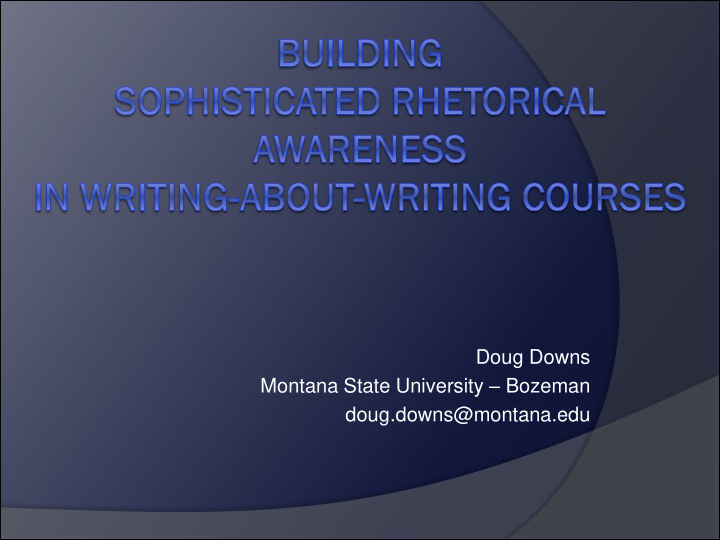



Doug Downs Montana State University – Bozeman doug.downs@montana.edu
Where We’re Going Dominant culture narratives of writing vs rhetorical understandings of writing Terms of a sophisticated rhetorical awareness Rhetoric-lite (what students are learning) Gambits toward teaching a sophisticated rhetorical awareness: ecology, experience, texts as people talking
Rugged-individualist writing Inspiration / genius Solo Originality / artistry Independence / freedom from others Unadulterated and clear transmission Non-interpretive / objective
Written Rhetorical Interaction Ecologies / networked communities of writing Distributed agency Collaboration Intersubjective construction of meaning Materiality and embodiedness of writing Sophisticated rhetorical awareness
Intersubjectivity The third way between objectivity and subjectivity which recognizes that meaning arises from the interaction among subjects and objects, and that meaning is established consensually among subjects. Writers are neither completely bound nor completely free.
Distributed Agency In a writing moment, many human and material elements influence the writing and thus have at least limited agency which prevents the writer’s perfect agency. Writers lack perfect control and instead struggle for control of their writing with various other animate and inanimate influences in their writing scene.
Rhetorical Ecology The settings in which “rhetorical situations” occur: networks of interacting agents that define the boundaries and shapes of related rhetorical situations. Rhetorical ecology works to account for the nearly infinite interconnections among agentive players, objects, and forces which give rise to specific texts.
Materiality We are not because we think (Descartes = so very wrong); we are because our hearts beat, so meaning is not purely of the mind but also of the body and the molecules that comprise it, and the materialities which our bodies inhabit. Written rhetorical interaction is born in matter and responds to it.
Exigence The circumstances, history, materialities, and events in an ecology that call a text into being. More specifically, the need, gap, or problem which demand a text to fill or solve. Why there needs to be a text to begin with. (Hint: it’s not because the writer had nothing better to do with their time.)
Activity and Activity Systems A group of people working together to accomplish some task / the structures that have evolved to allow the people to accomplish their purpose. One way of identifying a rhetorical ecology. Texts are tools that mediate particular activities; texts exist to help people accomplish other activities.
Sophisticated Rhetorical Awareness Understanding of one’s enmeshedness in rhetorical ecologies Awareness of texts (and the writing of them) as collaboration among a wide set of agents/agencies which shape the writing. A sense of how the text will impact the ecology and how to shape the text to account for those impacts.
Rhetoric Lite “Consider your audience” in the most general terms Logos/ethos/pathos as the depths of rhetoric “Constraints” = required paper format “Exigence” = what the writer wants to accomplish The rugged-individualist, free-agent rhetor
Students learn rhet-lite in high school (along with process-lite). The problem is that so many don’t appear to learn anything different even in WAW courses, though they get better language for the same unrealistic ideas about written rhetorical interaction.
Does sophisticated rhetorical awareness actually matter? Explaining lived experience Empowerment Transfer ( oh, and just generally being a completely badass human)
Call ecology ecology When in doubt, write it yourself Integrate rhetorical ecology, embodiment, felt sense, narrative knowing, informal logic, indentification, and classical rhetoric Connect to students’ lived experience
… Your average human is a genius at assembling a stream of disparate signals into a sensible whole, and this is the physical reality that rhetoric works with. A colleague of mine, Kimberly Hoover, accordingly describes rhetoric as “signal intelligence,” because rhetoric is ultimately about the ways that we make sense of and respond to the many signals in our experience of a moment — signals from other people, from our surroundings, and from our own bodies. … All this biology and physics together have the following implications for rhetoric: First, bodies matter to knowing, meaning-making, and interaction. So rhetoric must be about bodies as much as minds , and about the material as much as the conceptual. … Contemporary rhetoric, particularly feminist rhetorical theory, makes clear the centrality of the body in making meaning, knowledge, and rhetoric (Kirsch and Royster, Wenger). Second, because our knowledge, filtered through sensory perception, can only ever be partial and selective, human interaction can never be based on complete, objective knowledge. Objectivity is not physically or biologically possible for humans: we are limited to selectivity and partiality, which makes bias (literally slanting ) inevitable. We can be more or less objective by trying to get the most complete view of a situation or experience possible, but we can never achieve objectivity. Rhetoric must therefore not rely on, or be about the achievement of, objectivity. Rather, it must have something to do with letting people interact without objectivity — as subjective beings . …
Increase experiential learning Rely on WAW’s demonstrated strengths in mindfulness, self-efficacy, and self- actualization to help student reflectively establish connections between experience in non-student rhetorical ecologies and course readings. Primary research, service learning
Texts are people talking Leverage strengths in WAW curriculum for raising awareness that texts are not disembodied, self-authorizing factual litanies. Extend that awareness to understanding the people represented by the texts as embedded in rhetorical ecologies that have shaped their texts.
Sophisticated Rhetorical Awareness = Most threshold-y threshold concept ever? Probably, yes.
Recommend
More recommend